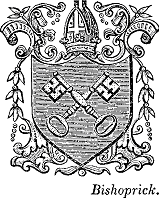Cashel Bishops
The first bishop of Cashel of whom any authentic notice occurs is Cormac Mac-Culinan, King of Munster, who, as was not uncommon at that period, exercised also spiritual jurisdiction over his subjects. He was descended from Aengus, and succeeded to the throne of Munster and to the see of Cashel, in 901, but was killed on his retreat from battle in 908, and interred in the abbey of Castledermot, where he was educated. From this period till 1152 only four of his successors are noticed, who, with the exception of one, are all styled archbishops of Cashel. Donat O'Lonargan, who then succeeded to the bishoprick, received from Cardinal Paparo, the legate of Pope Eugene III., one of the four palls which had been sent by him to Ireland, and of which the other three were conferred on Gelasius of Armagh, Gregory of Dublin, and Edan of Tuam. During the prelacy of Donald O'Hullucan, who succeeded in 1158, a synod was held here by command of Henry II., at which all the archbishops and bishops of Ireland, except the archbishop of Armagh, assisted, and at which Christian O'Conarchy, the pope's legate, and the bishop of Lismore presided.
exercised also spiritual jurisdiction over his subjects. He was descended from Aengus, and succeeded to the throne of Munster and to the see of Cashel, in 901, but was killed on his retreat from battle in 908, and interred in the abbey of Castledermot, where he was educated. From this period till 1152 only four of his successors are noticed, who, with the exception of one, are all styled archbishops of Cashel. Donat O'Lonargan, who then succeeded to the bishoprick, received from Cardinal Paparo, the legate of Pope Eugene III., one of the four palls which had been sent by him to Ireland, and of which the other three were conferred on Gelasius of Armagh, Gregory of Dublin, and Edan of Tuam. During the prelacy of Donald O'Hullucan, who succeeded in 1158, a synod was held here by command of Henry II., at which all the archbishops and bishops of Ireland, except the archbishop of Armagh, assisted, and at which Christian O'Conarchy, the pope's legate, and the bishop of Lismore presided.
At this synod Henry received from the archbishops and bishops charters, with their seals appended, by which they confirmed the kingdom of Ireland to him and his heirs, and constituted them kings and lords of Ireland for ever; transcripts of these charters were sent by the king to Pope Alexander, who by his apostolical authority gave his confirmation to them. Pope Innocent III., in 1210, confirmed to Donat O'Lonargan II., who had been promoted to the see in 1206, all the revenues and possessions of the archbishoprick, and subjected to his metropolitan jurisdiction the cathedrals of the suffragan bishopricks of Limerick, Killaloe, Fennabore, Waterford, Ardmore. Lismore, Cloyne, Cork, Ross, Ardfert, and Emly. Donald O'Brien, King of Limerick, about the time of the English invasion, built a new cathedral church, and converted the structure previously existing into a chapel or chapter-house; he also made large grants of land to the see, which was further endowed by his son Donat, surnamed Carbrac, with other grants of land in Thomond, and with the islands of Sulleith and Kismacayl, all which grants were confirmed by King John in 1215.
The see of Emly was united with the archbishoprick of Cashel by act of parliament in 1568, during the prelacy of James Mac-Caghwell, who succeeded to the dignity in 1567, and was the first archbishop of the united sees of Cashel and Emly. Miler Magragh, who was elevated to the united sees in 1570, was in high favour with Queen Elizabeth, from whom he held in commendam the sees of Lismore and Waterford, on his resignation of which he obtained a commendam of the two bishopricks of Killala and Achonry, in Connaught, which he held with the see of Cashel till his death. The grant of these sees appears to have been made to him and his heirs for ever, in the way of union to the see of Cashel. After the death of Archbishop Thomas Price, in 1684, the see remained vacant for a long period, during which the revenues were received by collectors appointed by the Crown, and distributed by James II., among the Roman Catholic bishops, no successor being appointed till 1690, when Narcissus Marsh became archbishop. By the Church Temporalities act (3rd of William IV.) it was specially provided that the see of Waterford and Lismore, then vacant by the death of Dr. Bourke, should be annexed to Cashel, which accordingly took place on the passing of that act, when the Temporalities of both dioceses, with the episcopal palace, became vested in the Ecclesiastical Commissioners.
